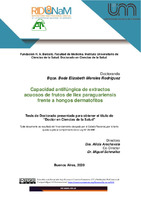Capacidad antifúngica de extractos acuosos de frutos de Ilex paraguariensis frente a hongos dermatofitos
Abstract
Numerosos estudios científicos dan cuenta acerca de las propiedades biomédicas y farmacológicas de los derivados de Ilex paraguariensis (Yerba mate). Sobre sus frutos, existen muy pocos estudios científicos realizados en cuanto a sus propiedades fitoquímicas y/o farmacológicas; y prácticamente nulos sobre la capacidad antimicrobiana de los mismos.
El objetivo de este estudio fue evaluar la capacidad antifúngica in vitro de extractos acuosos de frutos de I. paraguariensis sobre hongos dermatofitos.
Se trabajó con cepas aisladas de muestras clínicas, de las especies Trichophyton
mentagrophytes complex, Trichophyton rubrum, Microsporum canis, Trichophyton
tonsurans y Nannizzia gypsea. Para evaluar la capacidad antifúngica del extracto acuoso de yerba mate (EAFYM), se preparó una solución madre de 500 mg/ml. Se aplicó el método cualitativo de difusión en agar Müeller Hinton con un inóculo fúngico de 0,4-5 x 104 UFC/ml, y discos de papel embebidos con el EAFYM con concentraciones que oscilaron entre 10 mg/ml a 40 mg/ml. Asimismo se aplicaron métodos cuantitativos de microdilución en caldo RPMI y dilución en agar Müeller Hinton, con un inóculo fúngico de 1-3 x103 UFC/ml. Con las diluciones realizadas la concentración más alta del EAFYM fue de 125 mg/ml y la más baja de 0,49 mg/ml. Se realizaron controles de crecimiento fúngico, esterilidad y de antifúngicos comerciales de referencia. La incubación se realizó a 30ºC con controles diarios hasta 96 h. En la técnica cualitativa, la lectura consistió en la medición del halo de inhibición (mm) del crecimiento fúngico. En las técnicas cuantitativas,
en la observación visual del desarrollo fúngico a distintas concentraciones del EAFYM y la determinación de la mínima concentración que produjo inhibición completa (CIM) del crecimiento fúngico.
Por el método de difusión en agar se observó acción fungistática del EAFYM a una
concentración de 40 mg/ml. Mediante las técnicas de dilución se determinó que la CIM del EAFYM que inhibió el desarrollo fúngico estuvo entre 31,25y 125 mg/ml.
Se concluye que el EAFYM posee actividad antifúngica in vitro frente a las cepas de dermatofitos estudiadas. Numerous scientific studies account for the biomedical and pharmacological properties of derivatives of Ilex paraguariensis (Yerba mate). About theirs fruits, there are
very few scientific studies made regarding its phytochemical and / or pharmacological
properties; and practically null on their antimicrobial capacity.
The objective of this study was to evaluate the antifungal capacity in vitro of aqueous
extracts of fruits of I. paraguariensis on dermatophyte fungi.
We worked with strains isolated from clinical samples of the species Trichophyton
mentagrophytes complex, Trichophyton rubrum, Microsporum canis, Trichophyton
tonsurans and Nannizzia gypsea. To evaluate the antifungal capacity of the aqueous
extract of yerba mate (EAFYM), a stock solution of 500 mg/ml was prepared. The
qualitative method of diffusion in Müeller Hinton agar was applied with a fungal inoculum of
0.4-5 x 104 CFU/ml, and paper discs embedded with EAFYM with concentrations ranging
from 10 mg/ml to 40 mg/ml. Likewise, quantitative methods of microdilution in RPMI broth
and dilution in Müeller Hinton agar were applied, with a fungal inoculum of 1-3 x103
CFU/ml. With the dilutions performed, the highest concentration of EAFYM was 125 mg/ml
and the lowest was 0.49 mg/ml. Controls of fungal growth, sterility and commercial
reference antifungals were performed. Incubation was performed at 30 °C with daily
controls up to 96 h. In the qualitative technique, the reading consisted of measuring the
halo of inhibition (mm) of fungal growth. The quantitative techniques, consisted in the
visual observation of fungal development at different concentrations of EAFYM and the
determination of the minimum concentration that produced complete inhibition (MIC) of
fungal growth.
The antifungal activity of EAFYM was observed by the agar diffusion method at a
concentration of 40 mg / ml. The dilution techniques determined that the CIM of the
EAFYM that inhibited fungal development was between 31.25 and 125 mg/ml.
It is concluded that EAFYM has in vitro antifungal activity against the dermatophyte strains studied.
Collections
- Doctorado [62]
The following license files are associated with this item:



